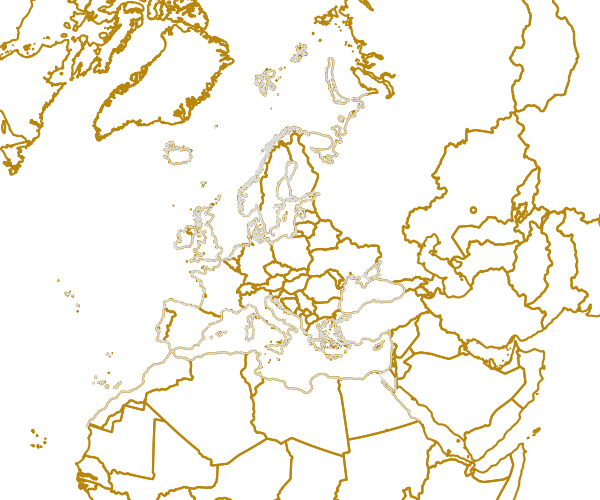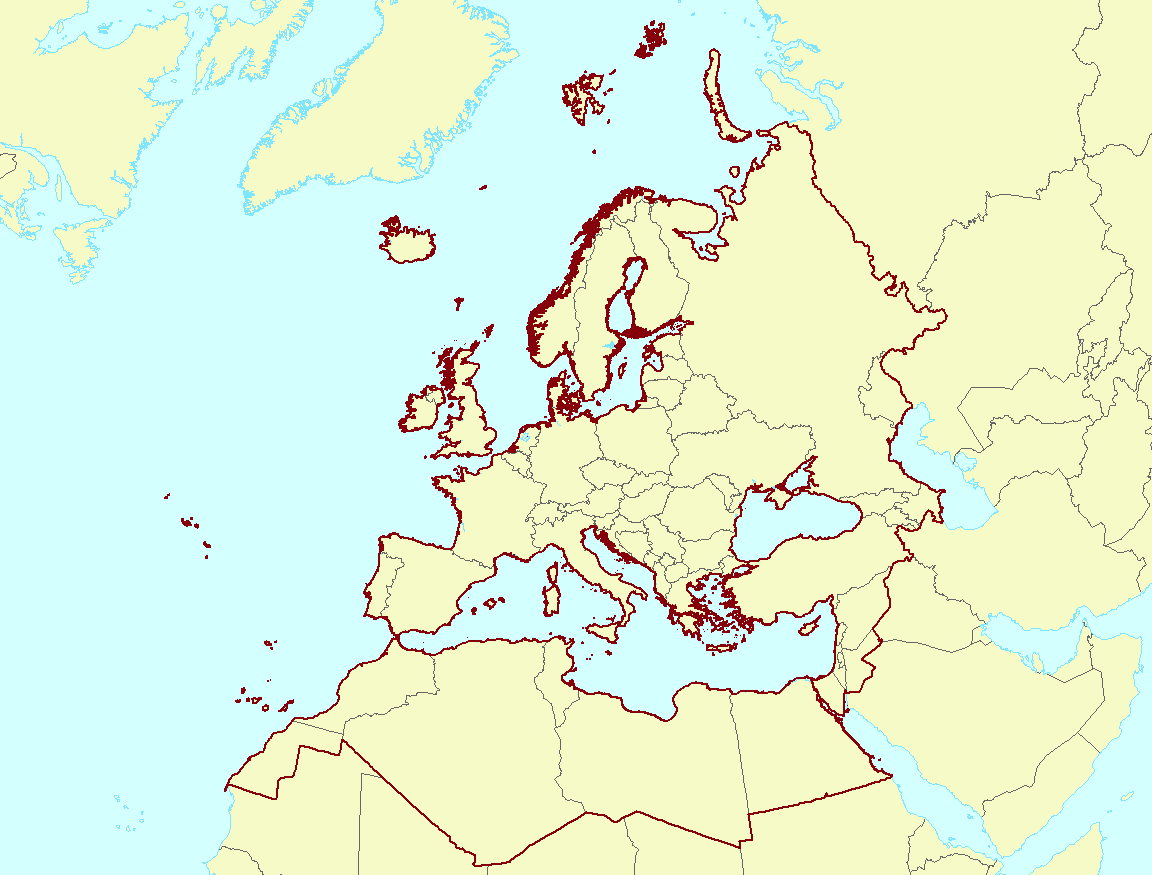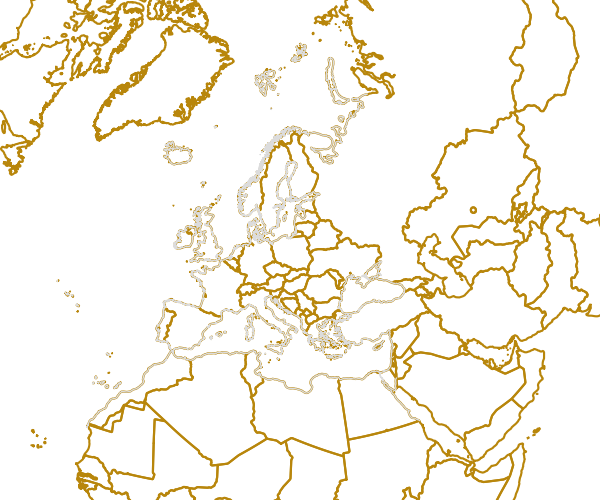Oceans
Type of resources
Available actions
Topics
INSPIRE themes
Keywords
Contact for the resource
Provided by
Years
Formats
Representation types
Update frequencies
status
Scale
Resolution
-

Draft version of the regions boundaries at sea to be used for the MSFD reporting. This dataset has not been approved by Member States.
-

The EEA coastline for analysis is created for highly detailed analysis, e.g. 1:100 000, for geographical Europe. The coastline is a hybrid product obtained from projects using satellite imagery as data source: EUHYDRO [link not available - yet] and GSHHG [http://www.soest.hawaii.edu/pwessel/gshhg/]. The defining criteria was altitude level = 0 from EUDEM [will become available from EEA website]. Outside the coverage of the EUDEM, the coastline from GSHHG was used without modifications. A few manual amendments to the dataset were necessary to meet requirements from EU Nature Directives, Water Framework Directive and Marine Strategy Framework Directive. In 2015, several corrections were made in the Kalogeroi Islands (coordinates 38.169, 25.287) and two other greek little islets (coordinates 36.766264, 23.604318), as well as in the peninsula of Porkkala (around coordinates 59.99, 24.42).
-

The EEA coastline for analysis is created for highly detailed analysis, e.g. 1:100 000, for geographical Europe. The coastline is a hybrid product obtained from projects using satellite imagery as data source: EUHYDRO [link not available - yet] and GSHHG [http://www.soest.hawaii.edu/pwessel/gshhg/]. The defining criteria was altitude level = 0 from EUDEM [will become available from EEA website]. Outside the coverage of the EUDEM, the coastline from GSHHG was used without modifications. A few manual amendments to the dataset were necessary to meet requirements from EU Nature Directives, Water Framework Directive and Marine Strategy Framework Directive. In 2015, several corrections were made in the Kalogeroi Islands (coordinates 38.169, 25.287) and two other Greek little islets (coordinates 36.766264, 23.604318), as well as in the peninsula of Porkkala (around coordinates 59.99, 24.42). This dataset is a polygon usable as a water-land mask.
-

The EEA coastline for analysis is created for highly detailed analysis, e.g. 1:100 000, for geographical Europe. The coastline is a hybrid product obtained from projects using satellite imagery as data source: EUHYDRO [link not available - yet] and GSHHG [http://www.soest.hawaii.edu/pwessel/gshhg/]. The defining criteria was altitude level = 0 from EUDEM [will become available from EEA website]. Outside the coverage of the EUDEM, the coastline from GSHHG was used without modifications. A few manual amendments to the dataset were necessary to meet requirements from EU Nature Directives, Water Framework Directive and Marine Strategy Framework Directive. In 2015, several corrections were made in the Kalogeroi Islands (coordinates 38.169, 25.287) and two other greek little islets (coordinates 36.766264, 23.604318), as well as in the peninsula of Porkkala (around coordinates 59.99, 24.42). This dataset consists of one single line for the whole coastline.
-
Maritime unit features and boundaries from Denmark. The contents are data from the data set "DAGI", transformed to the INSPIRE Maritime Units GML application schema v3.0.
-

The criteria for defining the coastline is the line separating water from land. The EEA coastline is a product derived from two sources: EUHYDRO [link not available - yet] and GSHHG [http://www.soest.hawaii.edu/pwessel/gshhg/] A priority defined in the input data, first EUHYDRO geometry and, as auxiliary data, GSHHG dataset. The EUHYDRO do not cover the requirement for EEA coastline. The EUHYDRO gaps are in Iceland, Canarias, Madeira, Azores, small islands (not represented in EUDEM) and the northern of Black Sea. The creation process was focused on generating the coastline as line dataset and, later, as a secondary product, defining the polygon layer sea-land. The fundamental step into the workflow was the selection of sea features using a water mask polygon (value in EUHYDRO datasets = 255). The inland water bodies (freshwaters) are rejected by this criteria, except the water bodies connected, at least by one point, to the sea (it is the cases of some transitional water bodies). A few manual amendments to the dataset were necessary to meet requirements from EU Nature Directives, Water Framework Directive and Marine Strategy Framework Directive. This dataset is a polygon usable as a water-land mask.
-

EuroGlobalMap is a topographic dataset that covers the EU (except Bulgaria), Andorra, Croatia, Faroe Islands, Greenland, Iceland, Liechtenstein, Moldova, Monaco, Norway, San Marino, Switzerland, Ukraine and Vatican at the scale 1:1 Million. It is produced in cooperation by the National Mapping Agencies of Europe, using official national databases. Thematic layers: administrative boundaries, hydrography, transportation, settlements, elevation points, named location. This metadata only refers to the coastline from EuroGlobalMap.
-

The criteria for defining the coastline is the line separating water from land. The EEA coastline is a product derived from two sources: EUHYDRO [link not available - yet] and GSHHG [http://www.soest.hawaii.edu/pwessel/gshhg/] A priority defined in the input data, first EUHYDRO geometry and, as auxiliary data, GSHHG dataset. The EUHYDRO do not cover the requirement for EEA coastline. The EUHYDRO gaps are in Iceland, Canarias, Madeira, Azores, small islands (not represented in EUDEM) and the northern of Black Sea. The creation process was focused on generating the coastline as line dataset and, later, as a secondary product, defining the polygon layer sea-land. The fundamental step into the workflow was the selection of sea features using a water mask polygon (value in EUHYDRO datasets = 255). The inland water bodies (freshwaters) are rejected by this criteria, except the water bodies connected, at least by one point, to the sea (it is the cases of some transitional water bodies). A few manual amendments to the dataset were necessary to meet requirements from EU Nature Directives, Water Framework Directive and Marine Strategy Framework Directive. This dataset consists of a series of contiguous coastal segments. The source of each of them (EUDEM, GSHHG...) is available as attribute.
-

The EEA coastline for analysis is created for highly detailed analysis, e.g. 1:100 000, for geographical Europe. The coastline is a hybrid product obtained from projects using satellite imagery as data source: EUHYDRO [https://land.copernicus.eu/pan-european/satellite-derived-products/eu-hydro/view] and GSHHG [http://www.soest.hawaii.edu/pwessel/gshhg/]. The defining criteria was altitude level = 0 from EUDEM [https://land.copernicus.eu/pan-european/satellite-derived-products/eu-dem/view]. Outside the coverage of the EUDEM, the coastline from GSHHG was used without modifications. A few manual amendments to the dataset were necessary to meet requirements from EU Nature Directives, Water Framework Directive and Marine Strategy Framework Directive. In 2015, several corrections were made in the Kalogeroi Islands (coordinates 38.169, 25.287) and two other Greek little islets (coordinates 36.766264, 23.604318), as well as in the peninsula of Porkkala (around coordinates 59.99, 24.42). In this revision (v3, 2017), 2 big lagoons have been removed from Baltic region, because, according to HELCOM, are freshwater lagoons.
-

The criteria for defining the coastline is the line separating water from land. The EEA coastline is a product derived from two sources: EUHYDRO [link not available - yet] and GSHHG [http://www.soest.hawaii.edu/pwessel/gshhg/] A priority defined in the input data, first EUHYDRO geometry and, as auxiliary data, GSHHG dataset. The EUHYDRO do not cover the requirement for EEA coastline. The EUHYDRO gaps are in Iceland, Canarias, Madeira, Azores, small islands (not represented in EUDEM) and the northern of Black Sea. The creation process was focused on generating the coastline as line dataset and, later, as a secondary product, defining the polygon layer sea-land. The fundamental step into the workflow was the selection of sea features using a water mask polygon (value in EUHYDRO datasets = 255). The inland water bodies (freshwaters) are rejected by this criteria, except the water bodies connected, at least by one point, to the sea (it is the cases of some transitional water bodies). A few manual amendments to the dataset were necessary to meet requirements from EU Nature Directives, Water Framework Directive and Marine Strategy Framework Directive. This dataset consists of one single line for the whole coastline.
 RUC Geo-Data catalogue
RUC Geo-Data catalogue